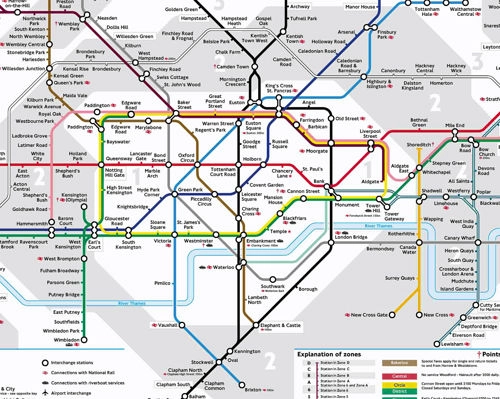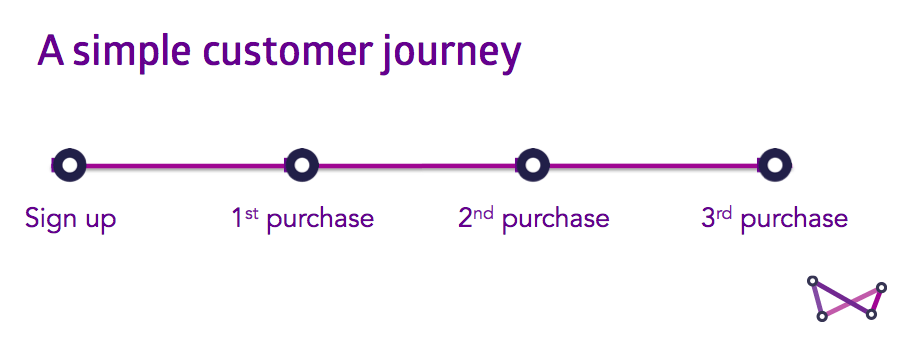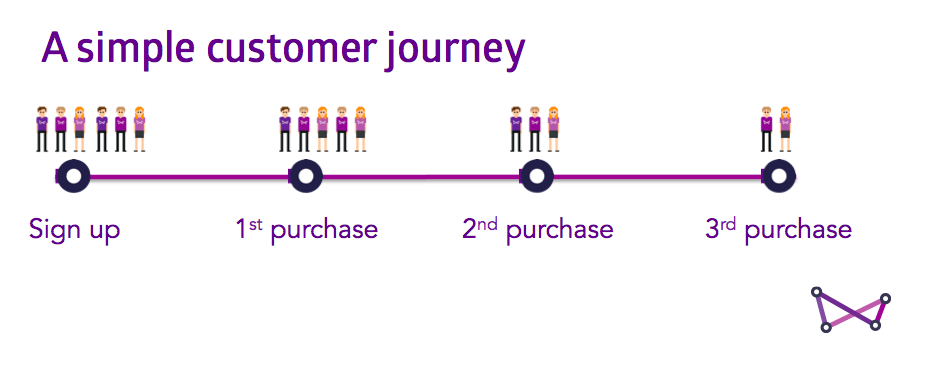How to manage your customer journey
If you are running a fast moving business or collecting a lot of data, then marketing automation is probably your only option to manage your customer journey.
Customer journeys can be both complicated and complex things to manage. Complicated in that the journey can involve lots of different configurations to manage, and complex in that they journey’s involve the one thing you can’t really control, the behaviour of your customers.
To take control of your customer journeys, we’ve found the best way is to create a process that keeps things simple, yet can react to the individual behaviour of customers and will allow you to evolve over time.
It’s a lot like the evolution of the railroads.
The importance of ruling your railroad
Did you know, that railroads were actually responsible for the birth of direct selling which has since evolved into E-commerce.
Back in 1883, railroads stretched across the US, but time was still driven by the sun – that makes running a national timetable really difficult, so the US time zones were created. That’s important, because it led to the Richard Sears, a station agent, from rural Minnesota, to start selling pocket watches to other guards. That earned him 10x his normal salary, and gave him both the idea and seed capital to creates the first ‘Sears’ mail order catalogue. And of course all the goods were sold by rail.
Pretty soon, Sears goes onto process over 35,000 orders a day, selling everything from refrigerators to pianos, and creates a new way of doing business.
And it continues, the emergence of this new way of business put even more importance on the railways. If you owned the railroad then you’re in control. Financial giant JP Morgan started in railroads, by 1900 he owned over half the railway track in the US.
Enough of history, let’s talk about your business and the railroads that exist within it.
Manage your customer journey like a railway tycoon
If you own the track, you are in control. The customer journeys that exist within your business are your very own railroad. If you can manage these customer journeys you’ll be in a better position to grow your business through more effective marketing to your customers.
The management of your customer journey / railroad has four parts.
The marketing plan – which is the train track
Your marketing strategy – which controls the timetable
Marketing messages – which are the trains that move passengers along the train track.
Your audience – the passengers of your railroad.
Now let’s investigate these in more detail, start understanding the customer journey and begin to take control like an old skool Railway tycoon.
Getting your marketing plan in place – building your Train track.
When you are planning any kind of journey, you’ll use a map of some description. If you get on the London underground at King’s Cross and you want to go to Victoria station, you’ll look at the map (like the one below), and pick your best route.

As you can see, that’s a pretty complicated map, and a daunting one. But it started with a single route. Your plan might get complicated in the future but you should start very simply – consider the plan below.

The plan is simple. Once someone has signed up, we want them to buy from us three times. That gives us four stations within our customer journey, and if you are already running a business, you’ll already have a number of passengers at each station.

Your marketing strategy – Your timetable
You’ve got your first customer journey mapped out. The plan is in place. Now it’s time to put the plan into action, and that means using your marketing strategy to create your timetable.
Let’s break it down…
The good folk at ‘Station – Sign Up’ – when are you going to send them a train that will take them to ‘Station – 1st purchase’.
Will you send them a train straight away when they arrive at Station – Sign Up. Or will you Welcome them first?
The reality is that some of the passengers at Station – Sign Up, could have been there for sometime, so you are going to need a range of different timetables to move the passengers out of the station.
The timetable could look like this.
When people first sign up, we will send them a Welcome message. Let’s assume that they’ve signed up because they want to buy something or want more information.
If people are still at Station Sign Up after one week, then we’ll give them an incentive to move them to Station – 1st Purchase.
If people are still at Station Sign Up after one month, then we’ll send them a reminder.
So we’ve started building on the first stage of the process. The different ways we can move our passengers from the start of their customer journey to the next stop on their journey with our business.
The same process will apply when you look at the different type of passengers that exist at each of the stations you’ve defined within your customer journey.
Customer segmentation techniques will give you the answers you need to make decisions in relation to your marketing strategy.
Creating your marketing messages – Building your trains
We are at stage three in the process. The marketing plan has given us the railroad and the stations along the way. The marketing strategy has set the timetable on who and when we are going to encourage to move to the next step of their customer journey. Now we need the communication vehicle to target each passenger.
In railroad terms, that would be the train. In marketing terms, it’s going to be your marketing messages.
Your marketing strategy has already set out the timetable for each message. Who it needs to be addressing, when they will receive the message and what we want the audience to do. So the brief for each of your messages is already set.
Here are some tips when creating your messages.
Your timetable provides a great brief, so follow it.
Make sure your messages are focused around the context of the audience and relevant as possible.
Make sure you include a clear call to action.
Tell the audience what they need to do next. I know it sounds obvious, but in the pressure of creating marketing messages, you’ll be surprised at how many messages don’t include this.
Use your brand personality.
The audience has arrived at this point in the journey for a reason. They like what you’ve already seen, that’s why they’ve signed up. So follow the same tone and use the same personality.
Managing your customer journey – understanding your passengers.
I mentioned earlier that customers were complex. Every customer has lots of reasons why they decide to purchase with our businesses. Sometimes the reasons change, sometimes their situations change.
These are things that you simply cannot control. You can understand them and make adjustments to your plans and processes accordingly. However, you can’t control the complexity of their individual circumstances.
It’s this complexity that gives the management of the customer journey real power.
With our ‘railroad’ we now know which ‘station’ each customer is currently at, which gives us context
We have an automated timetable of marketing activity. That timetable is our marketing strategy. Designed to send targeted marketing messages that are personalised and in context to each customer.
If you’ve been at Station Sign Up for a while – we’ll be reminding you.
If you’ve reached Station 3rd purchase – we’ll be welcoming you with something extra special.
In this post, we’ve created a simple example of a four station marketing strategy to manage your customer journey.
A strategy with up to three marketing messages related to each station of the journey, so up to 12 marketing messages in total. And, it’s a marketing strategy that is alive based on the behaviour and activity of your customers.
But remember, your role in this is to be the Railroad Tycoon. You need to oversee and control your marketing railroad, make sure that enough passengers are moving through the journey, and keep an eye on bottlenecks at each station.
Just as your marketing railroad reacts to each customer, you will occasionally need to change things, perhaps re-route a few trains, or even add in a few more railroads.
Why you should build your own marketing automation railroad
So that’s the plan in place. But we’ve also got evidence to back this up.
We’ve found that when Websand users put these types of plans in place, their marketing engagement (in terms of open rates) increases by up to 300%, and that in turn increases the overall customer value within their business, the best we’ve seen so far is an increase of 15% over a 6 months period.
If you’d like to know more, click the box below and let’s make you a Tycoon with your very own marketing railroad! All aboard!
It’s time to start getting more from your email marketing
Sign up for a free Websand demo and let’s show you how to get the best from your email marketing.